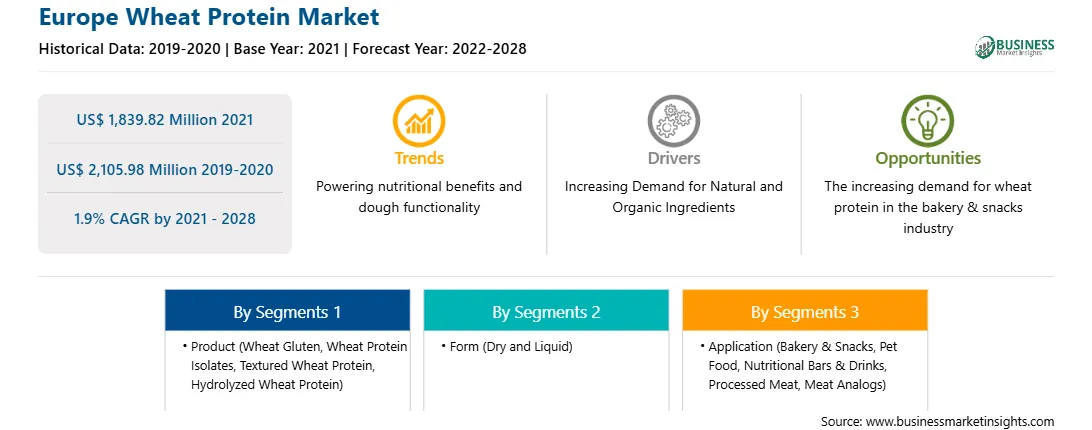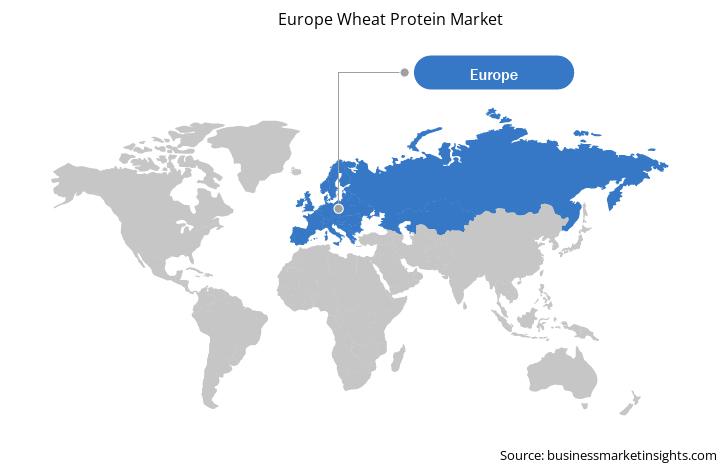Market Introduction
Europe comprises several developing economies such as Germany, France, Italy, the UK, and Russia amongst others. Transforming lifestyle trends concerning the food & beverages industry have had a noteworthy influence on the wheat protein market in Europe. The wheat protein market in Europe is witnessing growth, owing to the presence of well-established players such as Crespel & Deiters GmbH & Co. KG, CropEnergies AG, and Kröner-Stärke GmbH. With the increasing health awareness among consumers, the demand for plant protein products, including soy, wheat, and oat, is expected to grow during the projected period. The popularity of wheat protein has increased within the region, particularly in Italy, Norway, France, and the UK. Transforming lifestyle trends with regard to food & beverages has had a noteworthy influence on the wheat protein market in Europe.
In Europe, currently, the UK, France, and Russia are the hardest-hit countries by the COVID-19 outbreak. The region is estimated to suffer an economic hit due to the lack of revenue from various industries subjected to disruption in the supply chain. The disruptions in the supply chain, the shutdown of manufacturing units, and labor shortages had a negative impact on the wheat protein market. The lockdown restrictions were slowly lifted in the countries in Europe, like Denmark, where the shops and restaurants have reopened. In France, café terraces and cultural venues have been reopened since mid-May. The opening up of bakeries and food processing industries will have a positive impact on the wheat protein market. Along with this, the shift in consumer lifestyle and the rise in preference toward healthy food products will lead to an increased demand for wheat protein.
Market Overview and Dynamics
The wheat protein market in Europe is expected to grow from US$ 1,839.82 million in 2021 to US$ 2,105.98 million by 2028; it is estimated to grow at a CAGR of 1.9% from 2021 to 2028. Two major trends that are shaping the wheat protein market are the scaling demand for clean label products and the emerging shift toward vegan and vegetarian diets. The movement for the clean label has driven the demand for sustainable and straightforward ingredients. Such evolving lifestyle trends amid the food & beverages industry are anticipated to remarkably influence the purchasing decision of the consumers. Thus, the manufacturers of food & beverages in this region are adapting their offerings in accordance with prolonging sophistication in consumer preferences and facilitating supplements that would appeal to consumers' expectations. This has boosted the demand for wheat protein in Europe. Organic food consumption is the new trend among the consumers in Europe, which is again positively impacting the wheat protein market. Organic wheat farming has created a new product segment in wheat protein—organic wheat protein—which is especially utilized to make several high proteins and organic food products. Moreover, the percentage of consumers who opt for organic food is growing, implying a high demand for organic wheat and organic wheat protein. Thus, the organic movement is expected to grow at a high rate in the future and escalate the consumption of organic wheat protein.
Key Market Segments
Europe wheat protein market is segmented into product, form, application, and country. Based on product, the Europe wheat protein market is segmented into wheat gluten, wheat protein isolates, textured wheat protein, and hydrolyzed wheat protein. In 2020, the wheat gluten segment accounted for the largest revenue share. The Europe wheat protein market, by form, is bifurcated into dry and liquid. In 2020, the dry segment accounted for a larger revenue share. The Europe wheat protein market, by application, is segmented into bakery & snacks, pet food, nutritional bars & drinks, processed meat, meat analogs, and others. In 2020, the bakery and snacks segment accounted for the largest revenue share. Based on country, the Europe wheat protein market is segmented into France, Germany, Italy, UK, Russia, and rest of Europe. Rest of Europe held the largest market share in 2020.
Major Sources and Companies Listed
A few major primary and secondary sources referred to for preparing this report on the wheat protein market in Europe are company websites, annual reports, financial reports, national government documents, and statistical database, among others. Major companies listed in the report are Archer Daniels Midland Company, Cargill Incorporated, CropEnergies AG; Kröner-Stärke GmbH, Manildra Group, MGP Ingredients Inc., Roquette Frères, and Tereos Group.
Reasons to buy report
Europe
Wheat Protein Market
Segmentation
Europe Wheat Protein Market -
By Product
Europe Wheat Protein Market - By
Form
Europe Wheat Protein Market - By Application
Europe Wheat Protein Market - By Country
Europe Wheat Protein Market - Company Profiles
Strategic insights for the Europe Wheat Protein provides data-driven analysis of the industry landscape, including current trends, key players, and regional nuances. These insights offer actionable recommendations, enabling readers to differentiate themselves from competitors by identifying untapped segments or developing unique value propositions. Leveraging data analytics, these insights help industry players anticipate the market shifts, whether investors, manufacturers, or other stakeholders. A future-oriented perspective is essential, helping stakeholders anticipate market shifts and position themselves for long-term success in this dynamic region. Ultimately, effective strategic insights empower readers to make informed decisions that drive profitability and achieve their business objectives within the market.

| Report Attribute | Details |
|---|---|
| Market size in 2021 | US$ 1,839.82 Million |
| Market Size by 2028 | US$ 2,105.98 Million |
| Global CAGR (2021 - 2028) | 1.9% |
| Historical Data | 2019-2020 |
| Forecast period | 2022-2028 |
| Segments Covered |
By Product
|
| Regions and Countries Covered | Europe
|
| Market leaders and key company profiles |
The geographic scope of the Europe Wheat Protein refers to the specific areas in which a business operates and competes. Understanding local distinctions, such as diverse consumer preferences (e.g., demand for specific plug types or battery backup durations), varying economic conditions, and regulatory environments, is crucial for tailoring strategies to specific markets. Businesses can expand their reach by identifying underserved areas or adapting their offerings to meet local demands. A clear market focus allows for more effective resource allocation, targeted marketing campaigns, and better positioning against local competitors, ultimately driving growth in those targeted areas.

The Europe Wheat Protein Market is valued at US$ 1,839.82 Million in 2021, it is projected to reach US$ 2,105.98 Million by 2028.
As per our report Europe Wheat Protein Market, the market size is valued at US$ 1,839.82 Million in 2021, projecting it to reach US$ 2,105.98 Million by 2028. This translates to a CAGR of approximately 1.9% during the forecast period.
The Europe Wheat Protein Market report typically cover these key segments-
The historic period, base year, and forecast period can vary slightly depending on the specific market research report. However, for the Europe Wheat Protein Market report:
The Europe Wheat Protein Market is populated by several key players, each contributing to its growth and innovation. Some of the major players include:
The Europe Wheat Protein Market report is valuable for diverse stakeholders, including:
Essentially, anyone involved in or considering involvement in the Europe Wheat Protein Market value chain can benefit from the information contained in a comprehensive market report.